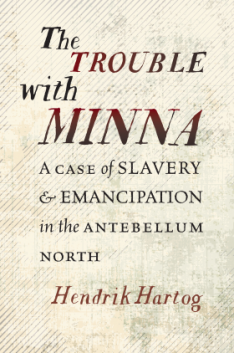
The book: Before the institution of slavery was abolished, there was a period of “gradual emancipation,” allowing slavery to be simultaneously legal and not, while the practice declined. Meanwhile, conflicting laws led to convoluted moral and legal situations, such as the 1836 New Jersey case of Minna, a slave who was leased to a woman, but then not received back by her former owner at the end of the lease. The woman sued Minna’s former owner for the future years of care she provided Minna, but it was ruled she had only extended the servant a “voluntary courtesy.”
Professor of history and law Hendrik Hartog explores this extraordinary scenario in The Trouble with Minna: A Case of Slavery & Emancipation in the Antebellum North (University of North Carolina Press), focusing on how beliefs about freedom, slavery, property, and contracts collided in this case during pre-abolition New Jersey. He delves deep into the historical moment, citing extensive legal arguments and cases in the 18th and 19th centuries to demonstrate the beliefs of the lawyers, judges, and the public about slavery, as well as how the language of “voluntary courtesy” appeared in a multitude of cases following the judgment about Minna.
The author: Hendrik Hartog is Class of 1921 Bicentennial Chair in the History of American Law and Liberty at Princeton University and author of Public Property and Private Power.
Opening lines: In September 1822, Elizabeth Haines, a widow, rented a slave. The lease was for a term of just under four years and cost the widow sixty dollars. As a result of the lease, a woman named Minna or Minner, whose last name was never given, left the household of her owner, Henry Force, to live with Mrs. Haines in Elizabethtown, one township over and about eight miles away.
At the time, the lease of a slave was a routine legal transaction. Like other rentals, it did not require an explanation. It is thus not surprising that Mrs. Haines never said anything about why she had rented Minna, nor did Mr. Force ever explain why he had let her go. Such limited-term transactions just happened.
What did the lease mean for Minna? For her, too, it was most likely not an unexpected event. The lease took place about a year after she had arrived in Mr. Force’s household, and it was quite possibly not the first or even the second time that she had been treated as transacted and commodified property in motion. Each such transaction must have been a difficult, perhaps fearful, moment in its way. There would be no reason to assume that Minna was getting anything out of the transactions, other than the chance to work for different masters and mistresses. And the consequences could have been much worse than that. Still, these were the terms of her life, as an enslaved person living in New Jersey. Her movement from one household to another was her lot, as it was for others like her. The lease remained a routine legal transaction, even as it was shaped by the global slave trade, the Middle Passage, the capitalist market for commodities, and also, perhaps, the rise of an antislavery persuasion. Minna had been leased—transferred from the control of one white person to another.But in 1836, more than thirteen years after the lease was made, long after the term had ended, Elizabeth Haines went to a county court to ask that Henry Force compensate her for the cost of Minna’s care. That would not have been a routine act on Haines’s part, and as far as I can tell, it was the only time Haines ever went to court to litigate a case. It was also a rare case of a lessee suing for compensation for the care of a lessor’s slave. But according to Mrs. Haines’s claims, Minna had been “worthless” as a worker; she drank, and she had become blind in one eye. Mr. Force had refused to take her back, even though Minna remained Force’s responsibility and her “care” was costly.
The county court ordered Force to pay damages to Haines. But in 1840, the New Jersey Supreme Court reversed the decision. Although Minna remained Force’s legal and moral responsibility, the appellate court decided that Haines had no right to compensation for Minna’s care. What Haines had done for Force, in caring for his slave and thus his property, was instead something the majority of the court defined as a “mere voluntary courtesy.”
Over the course of the next century, courts around the country often borrowed the language Justice Gabriel Ford used in writing what was treated as the majority’s opinion in Force v. Haines, sometimes without attribution. The case became an occasional citation for the principle that Anglo-American law would not reward those who voluntarily took on care responsibilities. It shaped the boundaries of a nebulous and much-contested late nineteenth-century doctrinal category in legal thought: the realm of “quasi-contract.” It exemplified the distinctiveness—the exceptionalism—of Anglo-American contractual theory, as often contrasted with Roman law and other European understandings. The activities of those understood in European law as “benevolent intervenors,” including those who provided many forms of care work, were taken instead to be the acts of mere “volunteers” or “officious intermeddlers.” Those who borrowed that language almost never identified it as coming out of a case about the care of a slave.
Reviews: “This remarkably provocative, thoughtful, and original work is marked by Hartog’s gift for storytelling, his mastery of the law, and his exquisitely nuanced appreciation for the quirks of human motivation as shaped by the codes of American legal culture.” – Amy Dru Stanley, University of Chicago

